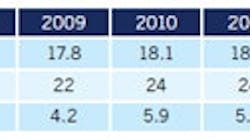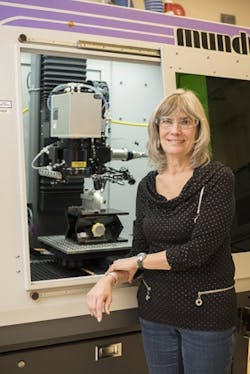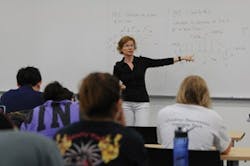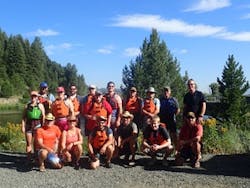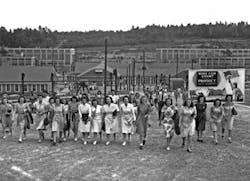We have all heard the stories and seen pictures of women in manufacturing while the men fought in World War II (think Rosie the Riveter). Why is it, more than 70 years later, that women’s numbers in industry are still so few?
In the 1940s, widespread advertising by governments and industry encouraged housewives to fill the gaps in these roles. They made simple arguments, such as: “Can you use an electric mixer? If so, you can learn to operate a drill.” Women heeded the call and succeeded in keeping the plants operating. Alas, the industry reverted to a predominantly male state when the war and advertising ended.
Georgia Tech has led the nation as the top producer of women engineers for at least 10 years.
This real-life case study illustrates how career decisions are influenced by simple awareness, advocacy, personal encouragement, professional mentoring, and leadership opportunities. Female industrial professionals today are quick to credit these factors for their choice of science, technology, engineering, and math (STEM) careers.
Professional organizations, academia, and primary and secondary schools are making great strides in encouraging girls toward STEM professions in lieu of more “traditional” female occupations. Women returning to the workforce or changing careers midstream are also paying attention.
Why is the imbalance a problem?
Pierrette Gorman, pictured here with a laser welding system, is the District 20 Director of the American Welding Society
We simply need more women engineers, remarks Gary May, dean of the College of Engineering at Georgia Institute of Technology (Georgia Tech). “The more diverse the field of engineering is, the more we will see innovative solutions to societal problems – problems that affect men, women, and children. We need to engage students of all genders, colors, and backgrounds to create a more robust economy.”
Women bring new points of view to the table. Examples including the minivan (a reflection of the inclusion of women engineers in the auto industry) and the evolution of voice-activated mechanisms (which originally only responded to men’s voices) are provided by Amy Freeman, assistant professor of engineering and assistant dean of Engineering Outreach and Inclusion at The Pennsylvania State University (Penn State).
Career choices begin to form as early as elementary school, but the STEM gender disparity starts to become evident at the undergraduate level. While women receive over half of bachelor’s degrees awarded in the biological sciences, they receive far fewer in the computer sciences (17.9%), engineering (19.3%), physical sciences (39%) and mathematics (43.1%) according to the National Girls Collaborative Project Statistics.
The challenge is not just attracting women to STEM fields, but keeping them there. According to the National Science Foundation (NSF) Science & Engineering Indicators, 2016, women made up half of the total U.S. college-educated workforce in 2013 but only 29% of the science and engineering workforce.
Following are approaches that have successfully drawn women into this arena.
Awareness and advocacy
It’s just not true that only math and science rock stars become engineers, says Christine Valle.
Elizabeth Taylor, lean engineer at Axalta Coating Systems, has been an active member of the Society of Women Engineers (SWE) since 2000 and is currently its Mid-Atlantic Region Governor. “As a freshman in college, I attended my first SWE meeting with a friend and since then I was hooked. It was a network and support system for my course load in chemical engineering. I've since advocated for my employers to send coworkers to region and society conferences and encouraged them to join as well,” adds Taylor.
Welding Engineer Pierrette Gorman made a mid-career transition from tailoring and is now on the board of directors of the American Welding Society (AWS). “When I investigated possible career choices and learned that welding jobs were plentiful, paid well and I would not be spending 40 hours a week in an office, I knew it was the right career for me. I think the biggest reason women do not enter the field of welding is because they were never offered the opportunity to consider it as a career.”
Student Assistant Lorna Treffert at the University of Tennessee Reliability & Maintainability Center (UT-RMC) says she would have never seriously considered this path had she not met an industrial engineer at a Women in STEM networking event at her high school. “She introduced me to a field that works with systems, logistics, optimization and, most importantly, people.”
Treffert hopes to apply her industrial engineering education to help revitalize the U.S. passenger rail industry. “It made sense for me to go into engineering because I have loved the synchronicity, comfort, and potential for sustainability of high-speed and other passenger train systems for as long as I can remember.”
Also new to the field is Michelle Coburn, who graduated from Clemson University in 2014 with a bachelor’s degree in chemical engineering and is now a project engineer at A&E Engineering. “I chose this career because I enjoy challenging myself and solving problems. Systems integration is a continuously changing field and requires working in many different industries.”
Encouragement and mentoring
Marya Woods, CEO at Apex Manufacturing Solutions, considers herself lucky to have had a very supportive professor who encouraged her to take a lead role in several projects while working toward her chemical engineering degree. He provided research opportunities and invited her to join his team doing efficiency consulting for a large food processor.
Woods happened into the controls field immediately after graduation. “I co-founded Apex because I was passionate about doing great work in the automation field and having a great place to work.” She has started going back to her alma mater to talk to freshman and senior classes about the type of engineering she does, and to help them better understand the diversity of jobs that are available when they graduate.
Penn State’s Freeman always enjoyed building things. “As a girl, this was unusual at the time, but I was fortunate and had parents who allowed me to be who I was and encouraged me to make positive changes in the world.”
Freeman took drafting in high school at a time when only boys were encouraged to do so. She also took a metal shop course in high school, but was only allowed to do so after completing a home economics class that was required of all girls at that time. “This was pivotal in that I did well in the courses and they made it clear to me that a technical job would be life changing,” she says.
Upon graduation from college, Freeman became a construction engineer at the Hanford Nuclear Reservation. “I know that every time I tell a girl, ‘Hello, I’m an engineer,’ I have just added to the list of occupations she knows are available to her, and I can see the future getting a little brighter.”
Axalta’s Taylor also sees value in mentoring. “My mentors have helped me identify opportunities that will help me succeed, course correct when I'm off track, and sometimes they just let me make mistakes so I can figure it out.” The Society of Women Engineers provides her an avenue to give back through STEM outreach events and encourage more young women to pursue engineering.
Working in a collaborative environment inspires A&E Engineering’s Coburn to become a mentor to those who will follow behind her. “I’ve been extremely fortunate to work for a distinguished firm full of experienced individuals who are willing to lend a hand. I try to encourage any young women interested in technology fields. I volunteer time with many organizations and actually coach at a local high school and try to prepare the girls for their futures after high school athletics.”
CEO Marya Woods believes in doing great work and having a great place to work. Here is the team on a company rafting trip.
Leadership opportunities
A key benefit of SWE is its professional development opportunities. Axalta’s Taylor works with current members to learn and understand their interests and seek out (or create) ways for them contribute. “A lot of our members get an opportunity to learn project, budget and people management in our society before they do in the workplace, which makes them a stronger candidate when the opportunity arises,” she explains.
Once women are in the field, they need to see women who love what they do, suggests Apex’s Woods. She maintains her visibility by participating in a Peer Group of the Control System Integrators Association, of which Apex is a member; and also in Vistage, an executive coaching association, to help her become a better leader as her company grows. In addition, Woods has been speaking with professors and deans at some of Idaho’s universities about the challenge of getting and keeping women in STEM fields.
Academia’s role
Christine Valle is the director of Georgia Tech’s Women in Engineering (WIE) program and a senior academic professional at the College of Engineering. WIE offers a full range of outreach programs, both on and off campus, for young women of all K-12 ages. It also supports other groups on campus that are dedicated to attracting more women into engineering. The efforts have been a resounding success. “Georgia Tech has been the #1 producer of women engineers in the country for at least a decade,” says Valle.
Shift change at the Manhattan Project’s Y-12 plant, 1945.
Part of UT-RMC’s mission is to facilitate internships with member companies for UT students studying Reliability & Maintainability Engineering (RME). “Our companies need a diverse workforce so we reach out to female students and other minorities,” says Kim Kallstrom, assistant director of UT-RMC. She works directly with SWE on campus to help get the word out, and she speaks at chapter meetings about the internship program and RME careers in general.
This year, 28% of the RMC interns and about 40% of the enrollment in the summer Reliability and Business Excellence course were female students. On the academic side, for the 2015-2016 school year, approximately 19% of the two core RME course enrollments were female students.
UT has also made a huge push to recruit women students and faculty into engineering, says Kallstrom. The College of Engineering’s undergraduate enrollment rose from 15% female students in 2010 to 19% by Fall 2015, and the Fall 2016 incoming freshman class is 22% female. Only 4.6% of the College of Engineering faculty was female in 2006 compared to 14% as of Fall 2016.
Under Freeman’s purview at Penn State is the Women in Engineering Program (WEP), which provides several recruitment and retention programs targeting women and girls at every stage of professional development. She is also currently president-elect for the Women in Engineering ProActive Network (WEPAN), a national organization advocating the inclusion of girls and women in STEM fields across the nation. “I have spoken across the U.S. and internationally regarding the importance of including women in the engineering and design process.”
Take a chance on STEM
STEM offers a world of opportunity but is often misunderstood. “Do not fall prey to easy stereotypes,” cautions Georgia Tech’s Valle. “It’s just not true that only math and science rock stars become engineers. Most young people I meet have really false impressions of engineering, especially women, since they traditionally have not pursued this field and thus lack role models with the adequate background.”
Engineering will train you to think in a unique way that’s highly sought after by employers of all kinds, adds Valle. For a young woman who wants to help others and make the world a better place, she believes there is no better field to go into than engineering because the options are limitless.
[sidebar id="8"]
